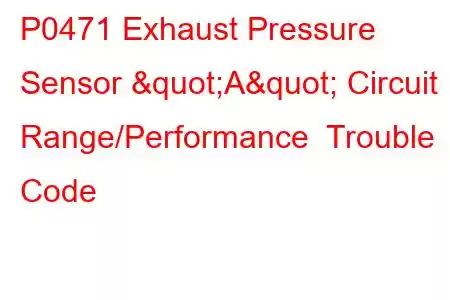P0471 Exhaust Pressure Sensor Range/Performance
OBD-II Trouble Code Technical Description
Exhaust Pressure Sensor Range/Performance
What does that mean?
This generic powertrain/engine diagnostic trouble code applies to all engines that use variable nozzle turbochargers (gas or diesel), starting around 2005 on Ford trucks equipped with 6.0L diesel engines, all Ford EcoBoost engines, and eventually leading to the Cummins 6.7L in 2007, the 3.0L in the Mercedes lineup in 2007 and here recently the Cummins 3.0L 6 cyl in the Nissan pickups starting in 2015. That's not to say you wouldn't necessarily get this code in a VW or other make though.
This code is strictly concerned about the incoming signal from the exhaust pressure sensor not matching intake manifold pressure or ambient air pressure at key on. This can be an electrical circuit fault or it can be mechanical.
Code P0470 may also be present at the same time as the P0470. The only difference between these 2 codes is how long the problem lasts and the type of electrical / mechanical problem that the sensor / circuit / engine controller is having. Troubleshooting steps may vary depending upon manufacturer, gas or diesel, type of exhaust pressure sensor and wire colors.
A typical exhaust pressure sensor:
Related exhaust pressure sensor trouble codes:
P0470 Exhaust Pressure Sensor "A" Circuit P0472 Exhaust Pressure Sensor "A" Circuit Low P0473 Exhaust Pressure Sensor "A" Circuit High P0474 Exhaust Pressure Sensor "A" Circuit IntermittentSymptoms
Symptoms of a P0471 engine code may include:
Check Engine Light illuminated Lack of power Unable to perform manual regeneration – burn off the soot out of the particulate filter. Looks like a catalytic converter but has temp sensors and pressure sensor probes inserted into it. If unable to perform regeneration, eventually may become a crank-no start.Potential Causes
Typically the causes for this code to set are:
Blockage in the tube from the exhaust manifold to the pressure sensor Exhaust Gas Recirculation system / Air Inlet / Charge Air leaks Exhaust Gas Pressure Sensor Possibly a powertrain control module (PCM) has failed (highly unlikely)Diagnostic and Repair Procedures
A good starting point is always a technical service bulletin (TSB) search for your particular vehicle. The vehicle manufacturer may have a PCM flash/reprogram to cover this issue, and it pays to check on this before you find you’ve gone down a long/wrong path.
Next, locate Exhaust Pressure Sensor on your particular vehicle. Once located, disconnect the tube that connects the sensor to the exhaust manifold. Attempt to blow through it. If unable to, try to run a small piece of wire through it to dislodge the carbon that is trapped inside, causing the fault code you are encountering. If you notice quite a bit of water blown out of it, this may have been the cause of the code.
If the tube is clear and free, visually inspect the connectors and wiring. Look for chafing, rubbing, bare wires, burn spots or melted plastic. Pull the connectors apart and carefully inspect the terminals (the metal parts) inside the connectors. See if they look corroded, burnt or possibly green in color versus the normal metal color you are probably used to seeing. You can get some Electrical Contact cleaner at any parts store if cleaning of the terminals is needed. If this is not possible, find some 91% rubbing alcohol and a light plastic bristle brush to clean them with. Afterwards let them air dry, get some dielectric silicone compound (same stuff they use for light bulb sockets and spark plug wires) and put some where the terminals come into contact. Next, make sure that the tube that connects the turbocharger to the intake manifold is not leaking. Visually inspect all tube connecti
Read: 46


